考博阅读理解.docx
《考博阅读理解.docx》由会员分享,可在线阅读,更多相关《考博阅读理解.docx(9页珍藏版)》请在冰豆网上搜索。

考博阅读理解
Text1
Themostnoticeabletrendamongtoday'smediacompaniesisverticalintegration(垂直统一管理),anattempt(尝试)tocontrolseveralrelatedaspects(方面)ofthemediabusinessatonce,eachparthelpingtheother.Besidespublishingmagazinesandbooks,TimeWarner,forexample,ownsHomeBoxOffice(HBO),Warnermoviestudios(摄影棚),variouscableTVsystemsthroughouttheUSA,andCNNaswell.TheJapanesecompanyMatsushitaOwnsMCA.RecordsandUniversalStudiosandmanufacturesbroadcastproductionequipment.
Todescribethefinancialstatus(财务状态)oftoday’smediaisalsototalkaboutacquisitions(获得).Themediaarebuyingandsellingeachotherinunprecedented(空前的)numbersandformingmediagroupstopositionthemselvesinthemarketplacetomaintainandincreasetheirprofits(利润).In1986,thefirsttimeabroadcastnetworkhadbeensold,twonetworksweresoldthatyear—ABCandNBC.
Mediaacquisitionshaveskyrocketed(猛增)since1980fortworeasons.Thefirstisthatmostbigcorporationstodayarepubliclytradedcompanies,whichmeansthattheirstockistradedononeofthenation’sstockexchanges(股票交易).Thismakesacquisitionsrelativelyeasy.
Amediacompanythatwantstobuyapubliclyownedcompanycanbuythatcompany'sstockwhenthestockbecomesavailable(有用的).TheopenavailabilitiesofstockinthesecompaniesmeansthatanybodywithenoughmoneycaninvestintheAmericanmediaIndustries,whichisexactlyhowRupertMurdochjoinedthemediabusiness.
Thesecondreasonfortheincreaseinmediaalliances(联合)isthatbeginningin1980,theFederalCommunicationsCommission(FCC)graduallyderegulated(解除管制)thebroadcastmedia.Before1980,forexample,theFCCallowedonecompanytoownonlyfiveTVstations,fiveAMradiostations,andfiveFMradiostations;companiesalsowererequiredtoholdontoastationforthreeyearsbeforethestationcouldbesold.Thepost-1980FCCeliminatedthethree-yearruleandraisedthenumberofbroadcastholdingsallowedforoneowner.Thistrend(倾向;趋势)ofmediaacquisitionsiscontinuingthroughoutthe1990s,aschangingtechnologyexpandsthemarketformediaproducts.
1.Whichofthefollowingistrueofthemedia?
A.Theyusedtosellandbuyeachotheringreatnumbers.
B.Theyaretradingeachotheringreaternumberstoday.
C.Theyusedtobecontrolledbytwonetworks—ABCandNBC.
D.Theyhavestoppedthetrendofacquisitionsinthe1990s.
2.Accordingtothepassage,whatmakesacquisitionseasier?
A.Thechangingtechnologyemployedbythemedia.
B.Themedia'sincreasingprofitsinthemarketplace.
C.TheevertougherregulationsoftheFCConthemediasince1980.
D.Theavailabilitiesofthemedia'sstocksonstockexchanges.
3.WhatistheFCC’snewpolicyregardingmediaalliances?
B.Itdoesn'tallowcompaniestoselltheirstockspublicly
C.Itpermitsonecompanytoownmoremediabusinessesatthesametime.
D.Ithaseliminatedallpost1980companies.
4.Theissueofmediaownershipisimportantbecause____.
A.itaffectstheamountofmoneythestockholderswillmake
B.itdecideswhetherwecanhavedifferentaspectsofthemedia
C.itconcernsthechannelsthroughwhichtoexpressopinions
D.itmeansthatmoreandmorepeoplewillholdontoonlyafewstations.
Text2
Severalanalogieshavebeenusedtoexplainhumanmemory,theconstructusedtoaccountforthewayexperiencesatonepointintimeinfluencebehavioratalaterpointintime.Plato(425-348BC),forexample,suggestedmemorywasanalogoustotheimpressionofmessagesonwaxwritingtablets.ForPlato,writingonthetabletrepresentedlearningsomethingnew,thetabletitselfwasthememorystore,andreadingthetabletslaterwasanalogoustotryingtorecallthestoredinformation.Likethewritingonawaxsurface,withthepassingoftime,memoriesbecamelessclear.Unfortunately,Plato’sanalogymissesanimportantcharacteristicofmemory,namelythatitisselective.Bywayofcontrast,onealwayshasaccesstotheinformationonthetablet,unlessallorpartofitisdestroyed.
Anotheranalogyisofmemoryandahologram.Ahologramisadevicewhichstoresathreedimensionalrecordofasceneusingphotographywithalaserlight.Evenifpartoftheholographicplateismissing,itispossibletoreconstructtheimagewiththepartsoftheplatethatremain.Experiencesorknowledgecanalsoberecalledusingincompletememories.Otheranalogiesinvolveartificialmethodsofstoringinformation,too.Thecomparisonofthemindtoacomputerisattractivebecauseitemphasizestheabilityofhumanmemorytorecallinformationquickly,butthesameobjectionsstatedabovewithregardtoPlato’shypothesisapplyhere.
Gregg(1975)hascomparedmemorytothefunctioningofataperecorder.Thelatterrecordssoundwaves,codedasmagneticpatternsontape,andstorethemovertime.Theinformationrecordedcanbedecoded,withoutdestroyingthetape,forlateruse.Greggpointsout,however,
thattheanalogyistoosimple.Humanmemoryisfarmoresophisticatedthantheworkingsofataperecorder.Itdoesnotsimplyrecordpassingeventspassively,forinstance;unlikethemachine,itisdynamic,capableofselectingwhichinformationitwillstore,andofarrangingthestoragesysteminmorethanjustasimplelinearfashion.
Blakemore(1977)hasnotedthatthediscoveryofDNA,themoleculethatcarriesgeneticinformation,hasprovidedscientistswithanothersourceofanalogytodescribememory.Thisanalogyproposesthateachexperienceresultsinthesynthesisofspecificchemicalmoleculesinthebrainandtheformationofnewmolecules.Thesesynthesizedmoleculesrepresentmemories.Thisdescriptionofmemorywouldprovideboththephysicalsubstrata(thesynthesizedmolecule)andthenatureofthecode(thespecificshapeofthemolecule).
Howeverattractiveagivenanalogymayappear,itisimportanttorecognizethelimitedfunctionofanalogiesinscienceingeneral.Asusedinscience,theyaregenerallysubstitutesforunderstanding,modelsthatguideresearch,notgenuineexplanationsofphenomena.Theyareusefuliftheyprovokeinvestigationsdesignedtoestablishdifferencesbetweenthethingscompared,dangerousiftheypromotecomplacentacceptanceasthesame,twothingswhicharereallydifferent.
11.Onedefinitionofhumanmemorygivenbytheauthoristhat______________.
A.experiencesmayinfluencebehavioratonetimebutnotatother
B.experiencesaccountforlaterbehavior
C.mentalconstructmayaccountforthewayexperiencesinfluencelaterbehavior
D.memoryisconstructedinthewaythataccountsforexperiences
12.ThehologramanalogyisbetterthanPlato’ssince_________________.
A.itisathreedimensionalrecord
B.itusesthemoderntechnologyofphotography
C.itincludestheknowncapacityofmemoryforrecoveringmissinginformation
D.ithasalargecapacityofstoringinformationthanPlato’swaxwritingtablets
13.Theauthorthinkstheanalogywithacomputeris___________________.
A.animprovementforthewaxtabletandhologramexamples
B.asobjectionableasPlato’s,thoughattractive
C.inappropriate,ifappliedtoPlato’shypothesis
D.anexactillustrationofthecharacteristicsofhumanmemory
14.Onelimitationofthetaperecorderanalogyisthat________________.
A.themachineisonlycapableofstoringinformationlinearly
B.memoriesaretoonumerabletoberecorded
C.themachineisonlygoodforrecordingsoundsbutnotforrecordinggraphs
D.thetape-recorderrecordspassingeventsonlybutthebrainpredictsthefutureaswell
15.Theauthorseesanalogiesas___________________-.
A.theendproductofscientificresearch
B.substitutesforinvestigationandunderstanding
C.inspirationsguidingfurtherresearchintounknownareas
D.modelsprovokinginvestigationintodifferencesbetweenthecomparedthings
Text3
“Museum”isaslipperyword.Itfirstmeant(inGreek)anythingconsecratedtotheMuses:
ahill,ashrine,agarden,afestivalorevenatextbook.BothPlatosAcademyandAristotlesLyceumhadamouseion,amusesshrine.AlthoughtheGreeksalreadycollecteddetachedworksofart,manytemples—notablythatofHeraatOlympia(beforewhichtheOlympicflameisstilllit)—hadcollectionsofobjects,someofwhichwereworksofartbywell?
knownmasters,whilepaintingsandsculpturesintheAlexandrianMuseumwereincidentaltoitsmainpurpose.
TheRomansalsocollectedandexhibitedartfromdisbandedtemples,aswellasmineralspecimens,exoticplants,animals;andtheyplunderedsculpturesandpaintings(mostlyGreek)forexhibition.Meanwhile,theGreekwordhadslippedintoLatinbytransliteration(thoughnottosignifypicturegalleries,whichwerecalledpinacothecae)andmuseumstillmoreorlessmeant“Muses-shrine”.
Theinspirationalcollectionsofpreciousandsemi-preciousobjectswerekeptinlargerchurchesandmonasteries—whichfocusedonthegold-enshrined,bejewelledrelicsofsaintsandmartyrs.Princes,andlatermerchants,hadsimilarcollections,whichbecamethedepositsofnaturalcuriosities:
largelumpsofamberorcoral,irregularpearls,unicornhorns,ostricheggs,fossilbonesandsoon.Theyalsoincludedcoinsandgems—oftenantiqueengravedones—aswellas,increasingly,paintingsandsculptures.Astheymultipliedandexpanded,tosupplementthem,theskillofthefakersgrewincreasinglyrefined.
Atthesametime,visitorscouldadmiretheverygrandestpaintingsandsculpturesinthechurches,palacesandcastles;theywerenot“collected”either,but“site-specific”,andwereconsideredanintegralpartbothofthefabricofthebuildingsandofthewayoflifewhichwentoninsidethem—andmostofthebuildingswerepublicones.However,duringtherevivalofantiquityinthefifteenthcentury,fragmen